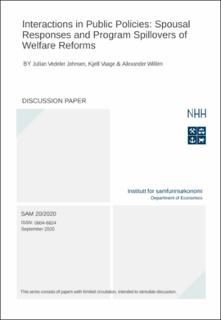Interactions in Public Policies: Spousal Responses and Program Spillovers of Welfare Reforms
Working paper

Åpne
Permanent lenke
https://hdl.handle.net/11250/2679360Utgivelsesdato
2020-09Metadata
Vis full innførselSamlinger
- Discussion papers (SAM) [657]
Sammendrag
Anticipating the labor market effects of welfare reforms is difficult due to public policy interactions across programs and among household members. Specifically, changes to one program may affect individual take-up of other programs, and individual participation in specific programs may generate labor market responses from other household members. This paper exploits an early retirement reform in Norway to provide new insights into these interactions. We first show that the reform had a substantial impact on the labor supply of those individuals who were directly affected by the reform, reducing the probability of employment by more than 30 percent. We then demonstrate that the increased take-up of early retirement had an offsetting effect on the take-up of alternative social security programs. Next, we reveal that the reform had a negative indirect impact on the labor supply of spouses of individuals directly affected by the reform, with an effect size of 5.5 percent. Finally, we show that the indirect effect on spousal labor force participation is accompanied by a significant increase in spousal take-up of disability insurance. We conclude that neglecting how public policies interact across both programs and household members can result in a miscalculation of the total impact of welfare reforms.